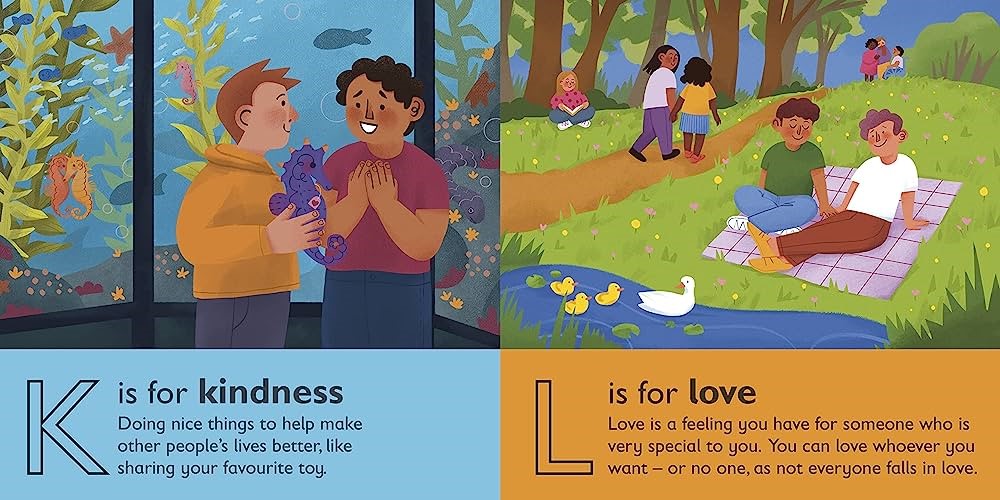
Inclusive Children's Book Teaching Guide
ABC Pride
What is this book about?
A is for Acceptance. B is for Belonging. K is for Kindness. L is for Love. ABC Pride introduces early learners to the alphabet through the colorful world of Pride.
Children can discover letters and words while also learning more about the LGBTQIA+ community and how to be inclusive.
Every letter of the alphabet is paired with fun, bold illustrations to support language learning. The author includes a list of discussion points at the end of the book to spark further discussion.
Who is depicted in this book?
- Diverse people and families engaging in acts of kindness and building community
What early childhood themes and concepts does this book explore?
- Activities that families and friends share
- Families come in different forms
- This is also an alphabet book, so capital letters and Pride-related vocabulary words are defined and illustrated on each page. Some of the more concrete vocabulary may be developmentally appropriate for younger children (e.g., rainbow, love, wig, flag, celebrate, kindness, march). More complex concepts related to identities are also included (trans, nonbinary, out), and these may be relevant to the children’s family and classroom experiences. Some of the more abstract concepts (stereotypes, understanding, values) will be challenging for young children to understand; however, the illustrations associated with these types of words typically feature people in relatable and celebratory contexts. So, while the words may be complex, the illustrations are not.
How does this book support anti-bias education?
ABC Pride can be used to affirm different types of people and families, introduce vocabulary that describes different types of people and families, and convey the message that families come in many forms but have one thing in common: the love that binds them together.
Depending on how the book is shared or used—and the developmental level of the children—ABC Pride may be used to support the following core goals from Anti-Bias Education for Young Children and Ourselves:
Identity—Teachers will nurture each child’s construction of knowledgeable and confident personal and social identities so that children will demonstrate self-awareness, confidence, family pride, and positive social identities.
Diversity—Teachers will promote each child’s comfortable, empathetic interaction with people from diverse backgrounds so that children will express comfort and joy with human diversity, use accurate language for human differences, and form deep, caring connections across all dimensions of human diversity.
How can this book be used to meet early childhood learning standards?
For all ages
Use ABC Pride to meet early childhood literacy standards
For children from birth to age three
Teaching suggestion: Point out and talk about the people and familiar objects in the book, noting featured characteristics and differences among them.
What Illinois Early Learning Guideline does this meet for children from birth to age three?
Developmental DomainLanguage Development, Communication and Literacy
Standard: Early LiteracyChildren demonstrate interest in and comprehension of printed materials.
Indicators for children:
- Points to pictures in a book and reacts (7–18 months)
- Imitates gestures and sounds during activities, e.g., hand actions during singing, babbling as caregiver reads book (7–18 months)
- Points to familiar pictures and actions in books (16–24 months)
- Expresses what happens next when reading a familiar book with a caregiver, e.g., uses gestures, words, and/or sounds (21–36 months)
Developmental DomainCognitive Development
Standard: Concept DevelopmentChildren demonstrate the ability to connect pieces of information in understanding objects, ideas and relationships.
Indicators for children:
- Begins to identify and name objects and people (16–24 months)
- Begins to identify characteristics of an object, e.g., “red ball” (16–24 months)
- Identifies characteristics of objects and people when named, e.g., colors (21–36 months)
Teaching suggestion: Point out families and their members and encourage the children to identify them and share their own family members’ names as well.
What Illinois Early Learning Guideline does this meet for children from birth to age three?
Developmental DomainSocial-Emotional Development
Standard: Self-ConceptChildren develop identity of self.
Indicators for children:
- Shows awareness of significant people by calling them by name, e.g. “papa” (7–18 months)
- Points to self in media (16–24 months)
- Names people in their family and shares stories about them (21–36 months)
Teaching suggestion: Point out examples of kindness, love and friendship in the book.
What Illinois Early Learning Guideline does this meet for children from birth to age three?
Developmental DomainLanguage Development, Communication and Literacy
Standard: Early LiteracyChildren demonstrate interest in and comprehension of printed materials.
Indicators for children:
- Points to pictures in a book and reacts (7–18 months)
- Imitates gestures and sounds during activities, e.g., hand actions during singing, babbling as caregiver reads book (7–18 months)
- Points to familiar pictures and actions in books (16–24 months)
- Expresses what happens next when reading a familiar book with a caregiver, e.g., uses gestures, words, and/or sounds (21–36 months)
For preschoolers (ages three to five)
Teaching suggestion: Identify letters while exploring the book.
What Illinois Early Learning and Development Standards does this meet for preschoolers?
Language Arts Standard4BDemonstrate an emerging knowledge and understanding of the alphabet.
Benchmark 4.B.ECa:
With teacher assistance, recite the alphabet.
Benchmark 4.B.ECb:
Recognize and name some upper/lowercase letters of the alphabet, especially those in own name.
Teaching suggestion: Select and share examples of ways that the book's characters are similar and different. Point out differences that the children might not notice on their own.
What Illinois Early Learning and Development Standards does this meet for preschoolers?
Social Studies Standard18AExplore people, their similarities and their differences.
Benchmark 18.A.ECa:
Recognize similarities and differences in people.
Teaching suggestion: Invite the children to talk about relationships and family structures. Ask questions such as: "Who is in your family? What is the same and different in these families? What is something great about your family?" Incorporate diverse family structures into pretend play and art projects.
What Illinois Early Learning and Development Standards does this meet for preschoolers?
Social Studies Standard18BDevelop an awareness of self within the context of family.
Benchmark 18.B.ECa:
Understand that each of us belongs to a family and recognize that families vary.
Teaching suggestion: Encourage the children to notice and discuss examples of kindness, love and friendship that they find in the book.
What Illinois Early Learning and Development Standards does this meet for preschoolers?
Social/Emotional Development Standard31BUse communication and social skills to interact effectively with others.
Benchmark 31.B.ECa:
Interact verbally and nonverbally with other children.
Benchmark 31.B.ECb:
Engage in cooperative group play.
Benchmark 31.B.ECc:
Use socially appropriate behavior with peers and adults, such as helping, sharing, and taking turns.
Teaching suggestion: Discuss some of the concepts portrayed in this book and how they relate to the rules of the classroom (e.g., justice, kindness, understanding, acceptance, difference, belonging) and why we try to follow those rules.
What Illinois Early Learning and Development Standards does this meet for preschoolers?
Social/Emotional Development Standard32ABegin to consider ethical, safety and societal factors in making decisions.
Benchmark 32.A.ECa:
Participate in discussions about why rules exist.
Benchmark 32.A.ECb:
Follow rules and make good choices about behavior.
Teaching suggestion: Use selected discussion questions from the list at the end of the book to encourage the children to think and talk about some of the book's themes and how they apply to early childhood classroom experiences.
What Illinois Early Learning and Development Standards does this meet for preschoolers?
Social/Emotional Development Standard31ADevelop positive relationships with peers and adults.
Benchmark 31.A.ECa:
Show empathy, sympathy, and caring for others.
Benchmark 31.A.ECb:
Recognize the feelings and perspectives of others.
Benchmark 31.A.ECe:
Develop positive relationships with peers.
Social/Emotional Development Standard31BUse communication and social skills to interact effectively with others.
Benchmark 31.B.ECa:
Interact verbally and nonverbally with other children.
Benchmark 31.B.ECc:
Use socially appropriate behavior with peers and adults, such as helping, sharing, and taking turns.
Social/Emotional Development Standard32CContribute to the well‐being of one’s school and community.
See inside this book.


What other resources are available?
Learn more about Pride flags and how to use them as teaching tools here.
